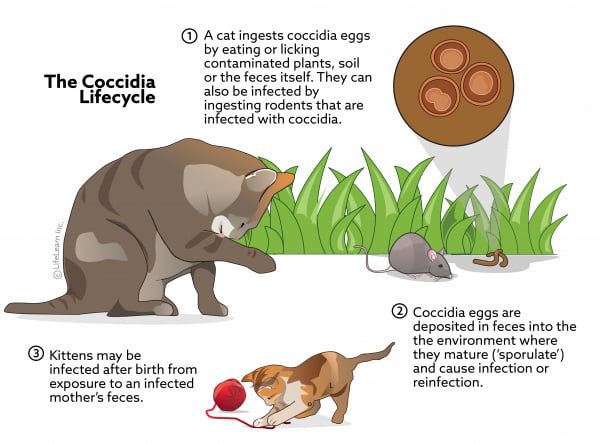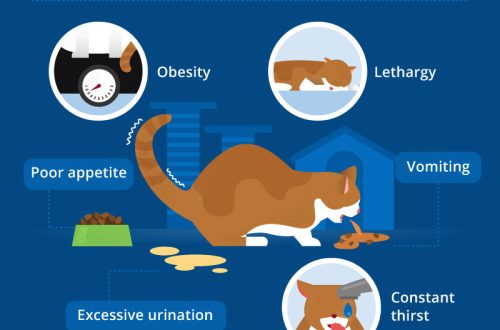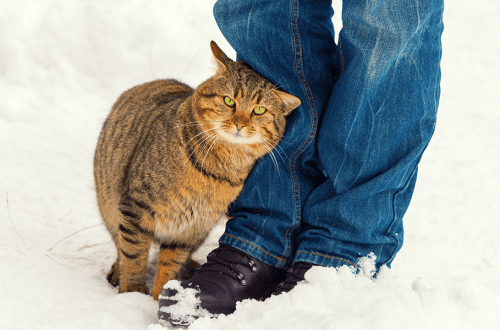
Coccidiosis in cats: symptoms and treatment
Coccidia live in the intestinal tract of kittens and adult cats. There are several types of these parasites that are found in cats and other mammals, and some of them can be infectious to humans. Fortunately, healthy adult cats rarely get coccidiosis, and most of them are able to cope with coccidia on their own, without treatment.
Contents
What is coccidiosis in cats
Coccidia are parasites that live in the gastrointestinal tract of cats and other mammals. In the intestines of pets, there can be up to two or three varieties. Among the most common types are Isospora felis и Isospore revolt, which only infect cats, and Cryptosporidium и Toxoplasma gondii, that are zoonotic, that is, they can be transmitted to humans.
Regardless of the species, any coccidia become infected through the accidental ingestion of sporulated oocysts, which represent the infective developmental stage of these parasites. Oocysts can be found in the stool of cats infected with coccidia, or in food or water contaminated with feces.
Toxoplasma can also be transmitted by eating raw meat infected with parasitic cysts. Therefore, pets that hunt or eat raw meat are at a higher risk of contracting coccidia.
Symptoms of coccidiosis in cats
Signs of a coccidia infection can vary depending on the type of coccidia and the age and health of the cat. In kittens, this condition is usually accompanied by more clinical signs than in healthy adult cats, because toddlers tend to have weaker immune systems compared to adult cats.
Adult cats may not show any signs at all – the cat may look and act perfectly normal and cope with the infection without treatment. Animals that have other health problems are at a higher risk of developing coccidiosis.
Symptoms of coccidiosis in kittens include watery or mucous diarrhea, sometimes with traces of blood. A severe form of infection with coccidia can cause weakness in babies.
In the case of Toxoplasma infection, the cat has either no clinical signs at all, or symptoms such as:

- excessive tiredness or drowsiness;
- weight loss;
- increased body temperature;
- excessive discharge from the eyes or squinting of the eyes;
- labored breathing;
- diarrhea;
- vomiting;
- loss of balance;
- convulsive seizures;
- weakness.
Another factor to consider is the likelihood of stillbirth in pregnant cats. However, cats are at a higher risk of contracting Toxoplasma than cats.
Diagnosis of coccidia in cats
If the owner suspects coccidiosis in a cat, it is necessary to make an appointment with a veterinarian. When traveling with a cat to an appointment, it is advisable to take a fresh stool sample with you for analysis. Typically, coccidiosis can be diagnosed based on the owner-provided history, physical examination of the cat, and microscopic examination of feces.
Since many pets can be infected without showing clinical signs, it is important to have a stool sample checked at least once a year. So you can make sure that she is not a carrier of this parasite and does not unwittingly infect other animals.
Fortunately, in the case of toxoplasmosis, cats shed parasite oocytes only for about 7 days after infection. And although reinfection can lead to the development of the disease in the pet, the risk that she will infect other pets or people in the house with this parasite.
If the cat is clearly ill or the veterinarian suspects toxoplasmosis or another disease, they may order additional tests. So, he will check how the internal organs of the cat function, and exclude other diseases. The specialist may also order blood tests to detect antibodies to Toxoplasma, to determine if the pet has been infected before and if there is an active infection in her body.
Treatment of coccidiosis in cats
Fortunately, most coccidiosis infections go away on their own. However, if necessary, these parasites are easily treatable.
In infections caused by a pathogen isospora, sulfadimethoxine is often given, and infected cats are treated until a stool test is negative for parasites.
Parasite infestation Cryptosporidium pets can be treated with antibiotics such as tylosin or paromomycin. In addition, another form of medication may be prescribed – more angry. In any case, the veterinarian will tell you which drug is best suited in a particular case.
Toxoplasmosis is likely to require treatment, especially if the animal is showing signs of illness. In this case, a two-week course of the antibiotic clindamycin is often prescribed. It can cause side effects in some cats, including loss of appetite, vomiting, and diarrhea. When they appear, you should contact your veterinarian.
Otherwise, the full course of all medications should be completed as prescribed, even if the owner seems to be feeling better.
If your cat is very ill or dehydrated, your veterinarian may recommend fluid replacement with subcutaneous or intravenous treatment solutions.
Parasite Prevention in Cats
Coccidia are found everywhere in the environment. Fortunately, most healthy adult cats can deal with them with their immune systems. Keeping your pet indoors and having a fecal test for any parasites every year is a good way to minimize exposure to internal parasites for both the pet and those around it.
Pregnant women are most at risk if they become infected with toxoplasma because the parasite can cause potentially fatal birth defects in the fetus. During pregnancy, women are advised not to clean the litter box, avoid handling cat feces, and wash their hands after playing with or touching pets.
You can also talk to your doctor about getting tested for Toxoplasma antibodies to assess your risk.
It is important to remember that the most common form of coccidia in cats is Isospora felis is not contagious to humans or dogs and most adult cats clear the infection without any treatment. However, if the kitten is still very small or the already adult cat looks unhealthy, you should not hesitate to seek help from a veterinarian.





